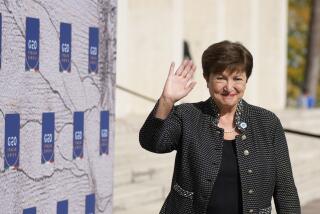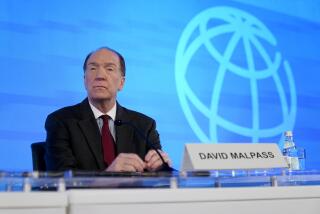Politician Succeeds Banker in No. 1 Spot : New President May Alter World Bank’s Role
- Share via
WASHINGTON — On Tuesday, former Republican congressman Barber B. Conable Jr. will be sworn in for a five-year term as president of the World Bank, succeeding A. W. (Tom) Clausen, who arrived at the post in 1981 from the presidency of Bank of America.
The switch at the top of the bank--from professional banker to professional politician--comes not only at a time of a new potential crisis over the $1-trillion Third World debt but at the precise moment when the bank is being urged to play a lead role and seize control of that issue from the International Monetary Fund.
The bank, under Clausen, has been widely criticized for underestimating the gravity of the debt crisis and for doing little to alleviate the problem during Clausen’s first two years--especially in Latin America--while the IMF has moved aggressively to take charge.
In an unsigned statement put out by the bank’s press office last week, Clausen rejected this criticism, noting that “few experts” had warned at the time he took charge that serious debt problems lay ahead.
But he acknowledged areas of disappointment, such as the reduction in funds made available to the International Development Assn. (IDA)--the bank’s arm that offers soft, or concessional, loans--and bluntly laid the blame for that on the United States.
He added, however, that there is now “a more positive (U.S.) attitude” toward IDA “and indeed towards the growth-oriented and efficiency policy thrust of the bank as a whole.”
The more sympathetic American view, while it comes too late for Clausen, yields an opportunity for Conable. The Overseas Development Council (ODC), a Washington think tank devoted to development problems, said Conable could set in motion a new five-point “World Bank initiative,” drastically altering the now well-known Baker initiative.
This new initiative would reduce interest payments on Third World debt, involve a substantial writeoff of debt in some countries and tap Japan’s huge surpluses as a new source of funds for needy countries.
The report, edited by ODC Vice President Richard Feinberg, calls for the bank to make a much greater percentage of its loans as “structural adjustment,” or program loans, over the next five or 10 years (as distinct from project financing).
Program loans are flexible and quick--disbursing advances for a speedy injection of cash into developing economies.
Following a line of thinking among some Treasury officials, the report suggests that a cooperative effort between the bank and IMF, frequently urged on the two agencies, begin by one of them assuming the lead role at the country level. Presumably, the bank would then take the lead in the 15 countries on the Baker initiative list and in hard-pressed sub-Saharan Africa.
The ODC report also argues that the IMF has been “fading out” of its role as principal helper to the Third World, its net disbursements to all borrowers having dwindled to only $560 million last year from a peak of $12 billion in 1983.
As a result of the falloff in IMF loans, a drop in World Bank lending and the drying up of commercial bank lending, the net flow of resources from rich to poor countries has turned down sharply.
In 1985, Third World countries transferred $22 billion to industrialized nations, almost three times the $8 billion in 1983. Just four years earlier, there was a positive flow of $19 billion.
Despite the common perception that the bank has been pumping out $11 billion to $12 billion in loans each year, the net annual flow of bank funds to all borrowers is much less. In 1985, for example, bank figures show that net transfers were only $2.4 billion.
The figures in the $11-billion-to-$12-billion range are lending commitments. Actual disbursements are much less, and from those, repayments of capital and interest must be subtracted.
Growth Encouraged
Feinberg has calculated that this year the IMF alone is drawing $4 billion in interest payments out of Third World countries on about $30 billion worth of outstanding loans. The probability is that the net transfers by the bank this year will fall to zero. Adding in a still-positive $2-billion outflow from IDA, the three agencies lumped together will receive $2 billion more from borrowing countries than they are lending or giving them in 1986.
The U.S. government, which, as the bank’s biggest stockholder, was instrumental in selecting the conservative Conable for the key job, looks to him to use the bank’s lending power to encourage economic growth rather than austerity in Third World countries.
Growth will enable debtor nations to earn foreign exchange to help service the debt; in the past few years, to squeeze out necessary cash for debt service, they have trimmed back imports from the United States, exacerbating the trade deficit problem here.
The American emphasis on economic growth rather than austerity, with the lead role shifting from the IMF to the bank, is a reversal of the Reagan Administration’s earlier policy. But whether or not the United States and other major stockholders in the World Bank are willing to give Conable the necessary tools is an open question.
Reforms Called For
The current framework for dealing with the problem is the Baker initiative, outlined by Treasury Secretary James A. Baker III last October in a speech to the joint World Bank-IMF meeting in Seoul.
It calls for 15 major debtors to reform their sometimes inefficient, state-managed economies. In exchange, the World Bank and other multilateral development banks would boost loans to them by $9 billion over the next three years.
The combination of market-oriented economic reform in the Third World, and the ‘umbrella’ effect of boosted multilateral bank loans is then supposed to attract an extra $20 billion in loans by the commercial banks.
Meanwhile, the World Bank would continue to give more attention to structural adjustment loans that encourage economic policy changes.
The question that Conable must face, along with major bank shareholders, the IMF, and the commercial banks, is whether the Baker initiative is enough.
Even as originally sketched out, it hasn’t got off the ground, in part because the unexpectedly sharp decline in oil prices intensified the debt problem for a handful of major borrowers such as Mexico.
The Baker plan has nonetheless been almost universally praised as the logical way for Third World nations to extricate themselves from debt.
But economic reforms have been slow. And with no net new commercial lending and flow of resources, money is going to the richer nations rather than in the other direction.
Baker, Clausen and IMF Managing Director Jacques de Larosiere have resorted to exhorting commercial bankers to renew lending. De Larosiere recently told a bankers’ group in Phoenix that “no debt strategy can succeed without the broad and active participation of commercial banks. A resumption of net new lending at a reasonable pace . . . ultimately provides the best protection for the value of outstanding loans to those countries.”
Baker remains optimistic. He says the process of a Third World shift toward the capitalist, market-oriented reforms he set as a requisite has a better chance of taking place if national leaders in the affected countries are allowed to make the changes necessary with little public fanfare.
Once in place, he expects those reforms to trigger more IMF and World Bank loans, thereby persuading commercial bankers to part with their money. So far, no one appears ready to make the first move.
Among the most critical problems for Conable will be steering the bank’s requests for money through Congress at a time of budget restraint triggered by the Gramm-Rudman-Hollings law.
Capital Increase
Despite Conable’s connections on Capitol Hill, it appears that it will be difficult to get a general capital increase (GCI) for the bank, or contributions to the new IDA three-year program--known as IDA-8--that will match the current U.S. annual $750-million donation to IDA-7.
Prof. Charles R. Blitzer of Massachusetts Institute of Technology, a staff member at the bank from 1971 to 1979, argues in the ODC report for a general capital increase of $100 billion, which he says would more than double bank net disbursements of $25.4 billion in the 1981-85 period to $65 billion over the next five years.
The capital increase could be callable, and not paid-in, which would mean no actual drain on the federal budget (barring some catastrophe that would require the bank to ‘call’ the capital shares from various governments).
On IDA-8, the U.S. public position is that the three-year program should be in a $10.5-billion to $12-billion range, with the absolute maximum annual U.S. contribution $900 million a year.
But Rep. David Obey (D-Wis.), has already warned Conable that unless the Administration asks for additional tax money, appropriations for the bank, IDA and all other foreign economic programs will suffer Gramm-Rudman slashes.
“I think we’re going to need a GCI,” said Obey, “but not out of borrowed money. That would be absurd, so the Administration will have to make some choices.”
“There’s no way they’re going to get that much for IDA” because of Gramm-Rudman limitations on the entire foreign aid budget, Rep. Jack Kemp (R-N.Y.) said in an interview.
Even the IDA-7 appropriation for fiscal 1986 is likely to be cut at least 20% in the markup after July 4, Obey said.
Development specialists call for a reduction of bilateral aid packages to Egypt, Israel and others in order to of beef up the funds available to the multilateral development banks.
Skepticism in Administration
But high Administration officials, who profess a willingness to fight for the multilateral banks, scoff at the suggestion.
A general capital increase for the bank--for which Clausen fought hard and fruitlessly--will run up against budget considerations even if there is no actual paid-in capital.
The Reagan Administration attitude, expressed by Baker, is that it will support a general capital increase when it is needed as backing for additional productive loans by the bank. But, according to this view, that time hasn’t come.
Against the mass of all of these problems, there have been numerous suggestions from bankers, academics and politicians for different game plans, ranging from a simple beefing-up of Baker’s proposed injection of an additional $29 billion of lending, to lower interest rates and a stretch-out of the debt, and a change in the bank’s “gearing ratio,” which would allow it to lend some multiple of its capital, instead of being limited to a 1-to-1 ratio.
Baker-plan skeptics such as Rep. Charles Schumer (D-N.Y.), argue that something more dramatic is needed.
Schumer wants a study by the Federal Reserve to explore the question of how much of the debt the Third World countries can repay without further cutting their living standards. He calculates that it’s no more than 70%.
A fairly common suggestion from all bank “reformers” is that Conable immerse himself personally in the solution of the international debt crisis, in much the same way that Baker, de Larosiere and Federal Reserve Board Chairman Paul A. Volcker have done.
“It’s shocking,” Feindberg said, that “the bank is on the sidelines and not up front” in Mexico.
John Sewell, ODC president, added: “Conable is being thrust into a tough job. It’s probably unfair, but if he doesn’t make a dent in the debt problem over his five-year term, he probably will be judged harshly.”
More to Read
Sign up for Essential California
The most important California stories and recommendations in your inbox every morning.
You may occasionally receive promotional content from the Los Angeles Times.










